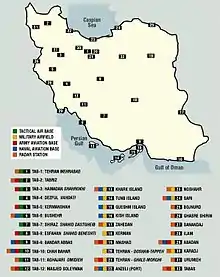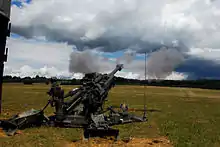Military base
A military base is a facility directly owned and operated by or for the military or one of its branches that shelters military equipment and personnel, and facilitates training and operations.[1] A military base always provides accommodations for one or more units, but it may also be used as a command center, training ground or proving ground. In most cases, military bases rely on outside help to operate. However, certain complex bases are able to endure on their own for long periods because they are able to provide food, water and other necessities for their inhabitants while under siege. Bases for military aviation are called military air bases, or simply "air bases". Bases for military ships are called naval bases.

The environmental impact of a given military base is dependent on its size and the manner of operation conducted at the base.[2] Commonly, habitat destruction, reductions in soil quality, chemical contamination, and noise pollution are among the environmental damages caused by military bases.[2] The environmental impacts of military bases are not always negative.[2] For example, installations dedicated to nuclear arms manufacturing and testing often improve biodiversity outcomes for the ecosystems where they are located via reduced human traffic through the area.[2]
Jurisdictional definition

Military bases within the United States are considered federal property and are subject to federal law. Civilians (such as family members of military officers) living on military bases are generally subject to the civil and criminal laws of the states where the bases are located.[3] Military bases can range from small outposts to military cities containing up to 100,000 people. A military base may belong to a different nation or state than the territory surrounding it.
Naming

The name used generally refers to the type of military activity that takes place at the base, as well as the traditional nomenclature used by a branch of service.
A military base may go by any of a number of names, such as the following:
- Ammunition dump
- Armory
- Arsenal
- Barracks
- Cantonment
- Casern
- Combat outpost (COP)
- DoDAAC
- Facility
- Fire support base (FSB, FB)
- Forward Operating Base (FOB)
- Fortification
- Garrison
- Installation
- Joint base
- Magazine
- Main Operating Base (MOB)
- Marine Corps base
- Military airbase, airfield or field
- Military camp
- Naval air station
- Naval base
- Naval dockyard
- Observation post
- Outpost (OP)
- Presidio
- Proving ground
- Reservation
- Shipyard or yard
- Station
Types of establishment

Depending on the context, the term 'military base' may refer to any establishment (usually permanent) that houses a nation's armed forces, or even organized paramilitary forces such as the Police, Constabulary, Militia, or Guards. Alternatively, the term may refer solely to an establishment which is used only by an army (or possibly other land fighting related forces, such as marines) to the exclusion of a base used by either an air force or a navy. This is consistent with the different meanings of the word 'military'.
Some examples of permanent military bases used by the navies and air forces of the world are the HMNB Portsmouth in Portsmouth, UK, the Naval Air Station Whidbey Island, Washington State, USA, or Ramstein Air Base, Germany (the last two are each designated as a Main Operating Base). Other examples of non- or semi-permanent military bases include a Forward Operating Base (FOB), a Logistics Base (Log base) and a Fire Base (FB).
A military base may also contain large concentrations of military supplies in order to support military logistics. Most military bases are restricted to the public and usually only authorized personnel may enter them (be it military personnel or their relatives and authorized civilian personnel).
In addition to the main military facilities on a certain installation, military bases usually (but not always) have various different facilities for military personnel. These facilities vary from country to country. Military bases can provide housing for military personnel, a post office and dining facilities (Restaurants). They may also provide support facilities such as fast food restaurants, gas stations, chapels, schools, banks, thrift stores, a hospital or clinic (dental or health clinics, as well as veterinarian clinics), lodging, movie theaters, and, in some countries, retail stores (usually a Supermarket such as Commissary and a Department Store, such as AAFES). On American military installations, Family, Morale, Welfare and Recreation (FMWR) provides facilities such as fitness centers, libraries, golf courses, Travel centers, Community service centers, Campgrounds, child development centers, youth centers, automotive workshops, hobby/arts and crafts centers, bowling centers, and community centers.

Bases used by the United States Air Force Reserve tend to be active USAF bases. However, there are a few Air Reserve Bases, such as Dobbins ARB, Georgia, and Grissom ARB, Indiana, both of which are former active-duty USAF bases. Facilities of the Air National Guard are often located on civil airports in a secure cantonment area not accessible to the general public, though some units are based on USAF bases, and a few ANG-operated bases, such as Selfridge ANGB, Michigan. Support facilities on Air National Guard and Air Force Reserve installations tend to not be as extensive as active bases; i.e., they usually do not have on-base lodging (though Kingsley Field ANGB, Oregon, is an exception), clinics (except for drill days), or retail stores (although some have small convenience stores)
In Russian usage "military base" or "naval base" is not limited to denoting a specific fence described facility and usually encompasses a broad territory within which a number of discrete facilities may be located. As an examples, 1) the Russian Sevastopol Naval Base comprises individual facilities located within the city of Sevastopol proper (waterfront moorings, weapons stores, a headquarters compound, and a naval infantry base) as well as an airfield at Kacha north of the city; 2) the Leningrad Naval Base comprises all naval facilities in the greater St. Petersburg area including training schools, commissioning institutes, the naval academy, and the Kronshtadt base on Kotlin island.
Overseas military base

An overseas military base is a military base that is geographically located outside of the territory of the country whose armed forces are the principal occupants of the base.
Such bases may be established by treaties between the governing power in the host country and another country which needs to establish the military base in the host country for various reasons, usually strategic and logistic.
Furthermore, overseas military bases often serve as the source of the military brat subculture due to the children of the bases' occupant military being born or raised in the host country but raised with a remote parental knowledge of the occupant military's home country.
British military bases
In the 18th and 19th Centuries the Royal Engineers were largely responsible for erecting military bases in the British Isles and the British Empire. In 1792 the Chief Engineer was instructed to prepare the Barrack Construction estimates for Parliament and at the same time the Department of the Barrackmaster-General was established.
During the period from the 1840s through the 1860s barracks were constructed under supervision of the Royal Engineers in:
- Bristol (1847)
- Preston (1848)
- Tower of London (1851)
- Sheerness (1854)
- Sheffield (1854)
- Curragh Camp (1855)
- Devonport (1856)
- Chelsea (1861)
The Cardwell Reforms (1872) ushered in another period of intensive Barrack building at Aldershot, Portsmouth, Plymouth, London, Woking, Woolwich, Dublin, Belfast, Malta, Gibraltar and the Cape of Good Hope.
In 1959 the Corps' Work Services was transferred to the civilian War Department Works Organization (later renamed Property Services Agency (PSA)) and by 1965 the (Specialist Teams Royal Engineers (STRE)) were formed to plan and execute Works projects worldwide.
Some British and Commonwealth naval bases are traditionally named, commissioned, and administered as though they were naval ships. For this reason they are sometimes called stone frigates.
Environmental Impact
Impacts of Construction

The development of military bases, like any construction project, has the potential to carry a number of environmental consequences.[2] Due to the various operational purposes of bases and the unique biophysical factors surrounding each area, the impact of development is unique to the location in which it occurs.[2] A training base to be constructed in a dense, forested area will involve the elimination of vegetation.[2] This would lead to increased rates of soil erosion and water runoff, which could change the biophysical processes of the ecosystem, rendering it potentially uninhabitable to the plant and animal species that once existed in that space.[2] Conversely, a naval base to be constructed on an artificial island runs the risk of irreversibly changing the dynamics of the host ecosystem which could have negative implications for biodiversity.[4] Broadly, detrimental impacts from the establishment and construction of bases may include changes to soil structure, habitat fragmentation, and eco-toxicity.[2]
Contamination from Military Bases
Military base operations and maintenance often result in the deposition of hazardous materials into the environments in which they exist.[5] For example, in 2001 the United States Forces Korea Yongsan Garrison and Camp Kim bases had been linked to an oil spill.[6] As a consequence of the spill hazardous chemicals including toluene, xylene, and benzene were found in the nearby groundwater which local peoples and ecosystems depend on at 958 times a safe level.[6] Similarly, abandoned United States Forces bases in Afghanistan and the surrounding areas were found to be rife with long-lasting toxic elements from base operations.[7] Such contaminants have been associated with damage to the respiratory and digestive systems of human populations and local wildlife alike.[7] Contamination from base operations and maintenance is so pervasive that 149 active and abandoned domestic United States Forces bases have been listed by the United States Environmental Protection Agency as among the most toxic areas in the continental United States.[8] Though the kind of contamination will depend on the specific operations of the base, frequent causes include pesticide use, fuel spills, and testing or training involving the live-fire of munitions.[2] Furthermore, military bases dedicated to the development of nuclear arms have been associated with the contamination of the atmosphere and the surrounding environment by radiative elements.[9] This increases the risk to surrounding wildlife of contracting several chronic health issues including cancer.[9]
Impacts from Training and Testing

Military training activities are often harmful to the ecosystems in which they take place.[2] The repeated firing of explosive munitions can irreversibly change the nature of an ecosystem. This destruction renders the land uninhabitable for some of its composite species.[2] The use of armoured vehicles can further damage the environment in which they are employed.[2] Local floral species are ground to a pulp under their immense weight, and changes in soil composition—often to the detriment of the ecosystem—are commonplace.[2] Wildlife may also be struck by stray bullets, explosive munitions, and armoured or aerial vehicles.[2] Additionally, noise pollution is a common side-effect of military training activities, which is particularly problematic for the marine life which surrounds naval military bases.[2]
Beneficial Impacts
_(32306278790).jpg.webp)
The environmental impact of military bases are not entirely negative. Typically military bases exist in isolated areas, are subject to only minor human traffic, and are lightly developed compared to civilian areas.[10] Because of this, and despite the aforementioned negative impacts, military bases are home to many endangered species.[10] One such example is the Red-Cockaded Woodpecker, found in their largest numbers at United States Forces Bases in Georgia, South Carolina, and North Carolina.[5] Recently, Fort Bragg, a United States Forces Base located in North Carolina, collaborated with conservationists to restore Red-Cockaded Woodpecker populations. As a result, they are no longer considered an endangered species.[11]
Adaptation Efforts
A changing climate will impact the operation of United States Forces bases, according to United States Secretary of Defence Lloyd J. Austin III.[12] At present, half of the military facilities owned and operated by the United States are vulnerable to climate-related impacts.[13] For example, the Offutt Air Force Base, located in Nebraska, United States, was victim to extreme flooding in spring of 2019.[14] This has impacted base readiness, and it will take approximately four years to return former operational function.[14] Recently, the United States armed forces has taken interest in constructing more sustainable, resilient military bases to adapt to this rising threat.[14] Currently, the United States Armed Forces is investigating private partnerships to modernize United States Forces Bases with clean technology and looking to improve data collection pertaining to climate change and environmental risks.[14]
Related term
- Billet
- Kaserne
See also
- List of United States military bases
- List of military bases
References
- Thackrah, J. R. (April 3, 2018). "Military base definition". Collins English Dictionary. Retrieved April 3, 2018.
- Lawrence, Michael J.; Stemberger, Holly L.J.; Zolderdo, Aaron J.; Struthers, Daniel P.; Cooke, Steven J. (2015). "The effects of modern war and military activities on biodiversity and the environment". Environmental Reviews. 23 (4): 443–460. doi:10.1139/er-2015-0039. ISSN 1181-8700.
- "Smoke a Joint in the These States, But Not On Base". Military.com. 2016-11-25. Retrieved 2018-04-09.
- "The Rising Environmental Toll of China's Offshore Island Grab". Yale E360. Retrieved 2022-06-27.
- "Proving Grounds: Militarized Landscapes, Weapons Testing, and the Environmental Impact of U.S. Bases". Journal of American History. 103 (1): 223–224. June 2016. doi:10.1093/jahist/jaw094. ISSN 0021-8723.
- Bae, Yooil. "Reality Revealed: U.S. Military Bases, Environmental Impact and Civil Society in South Korea".
{{cite journal}}: Cite journal requires|journal=(help) - Atherton, Kelsey D. "U.S. Forces Are Leaving a Toxic Environmental Legacy in Afghanistan". Scientific American. Retrieved 2022-06-24.
- "Military bases' contamination will affect water for generations". Center for Public Integrity. 2017-08-18. Retrieved 2022-06-24.
- Prăvălie, Remus (2014-10-01). "Nuclear Weapons Tests and Environmental Consequences: A Global Perspective". Ambio. 43 (6): 729–744. doi:10.1007/s13280-014-0491-1. ISSN 1654-7209. PMC 4165831. PMID 24563393.
- "Military Bases Serve As Safe Haven For Endangered Species". NPR.org. Retrieved 2022-06-27.
- "How The Military Helped Bring Back The Red-Cockaded Woodpecker". NPR.org. Retrieved 2022-06-27.
- "Department of Defense Climate Risk Analysis" (PDF). Department of Defense, Office of the Undersecretary for Policy. October 2021.
- "Half of U.S. military facilities vulnerable to extreme weather and climate risks". www.science.org. Retrieved 2022-06-27.
- "Building smarter military bases for climate resilient communities". Atlantic Council. 2021-10-01. Retrieved 2022-06-27.
External links
- Official Directory of US Military bases.
- Royal Engineers Museum Military Works (construction)
- New US Military Bases: Side Effects Or Causes Of War? by Zoltan Grossman
- US Office of the Deputy Under Secretary of Defense (Installations and Environment)
- Outposts of Empire – Booklet and map of the American military bases in the world. Transnational Institute, March 2007